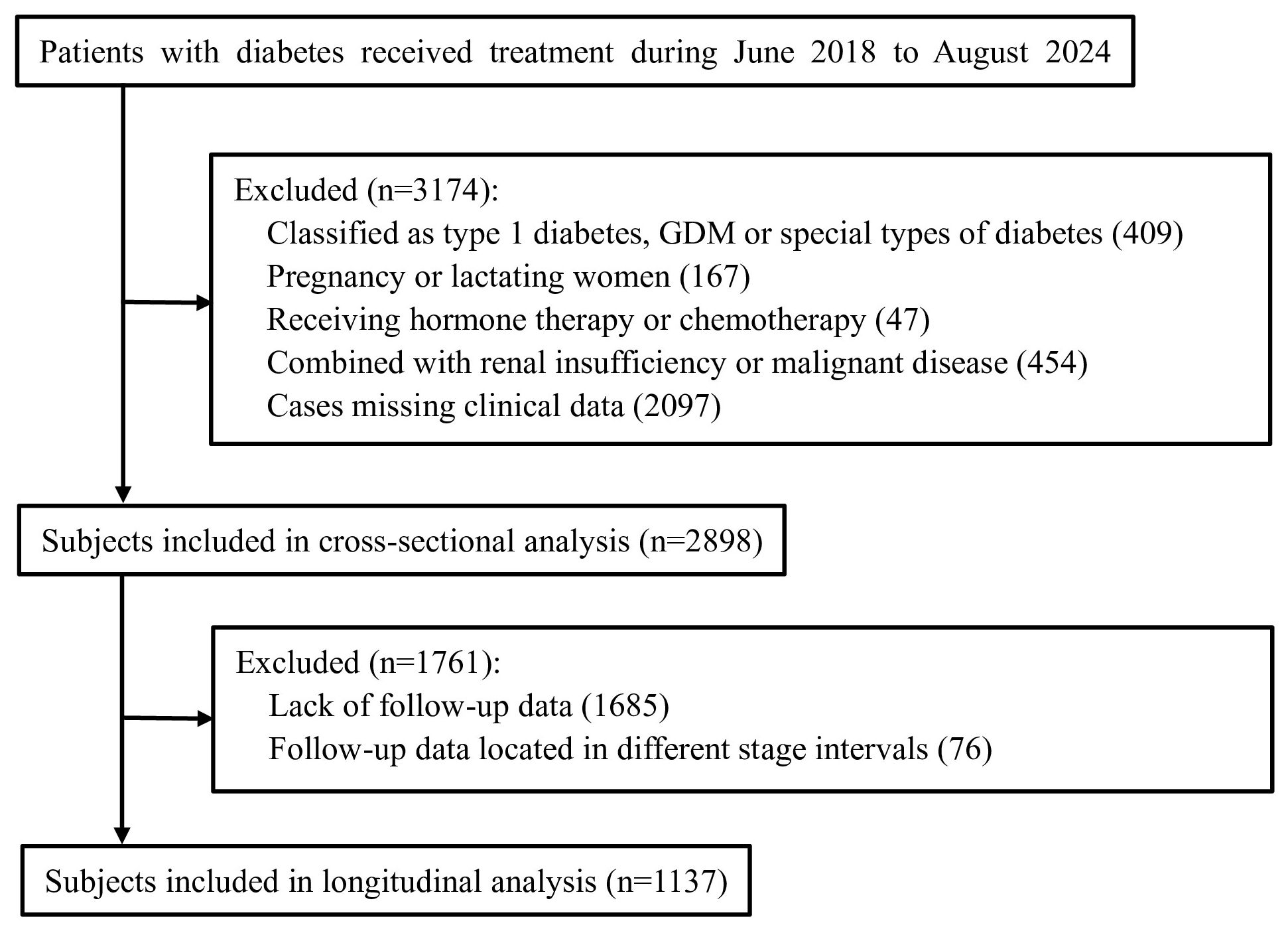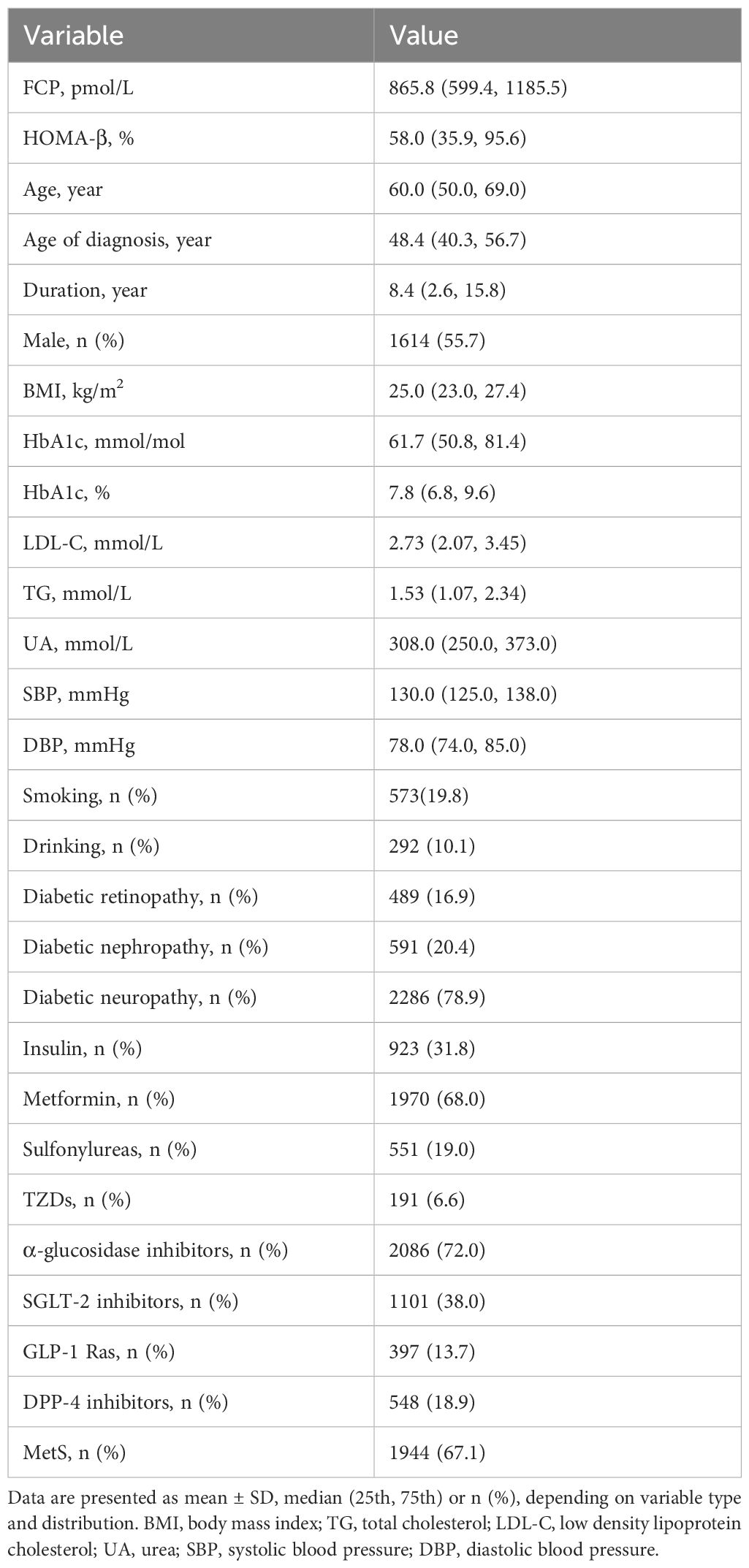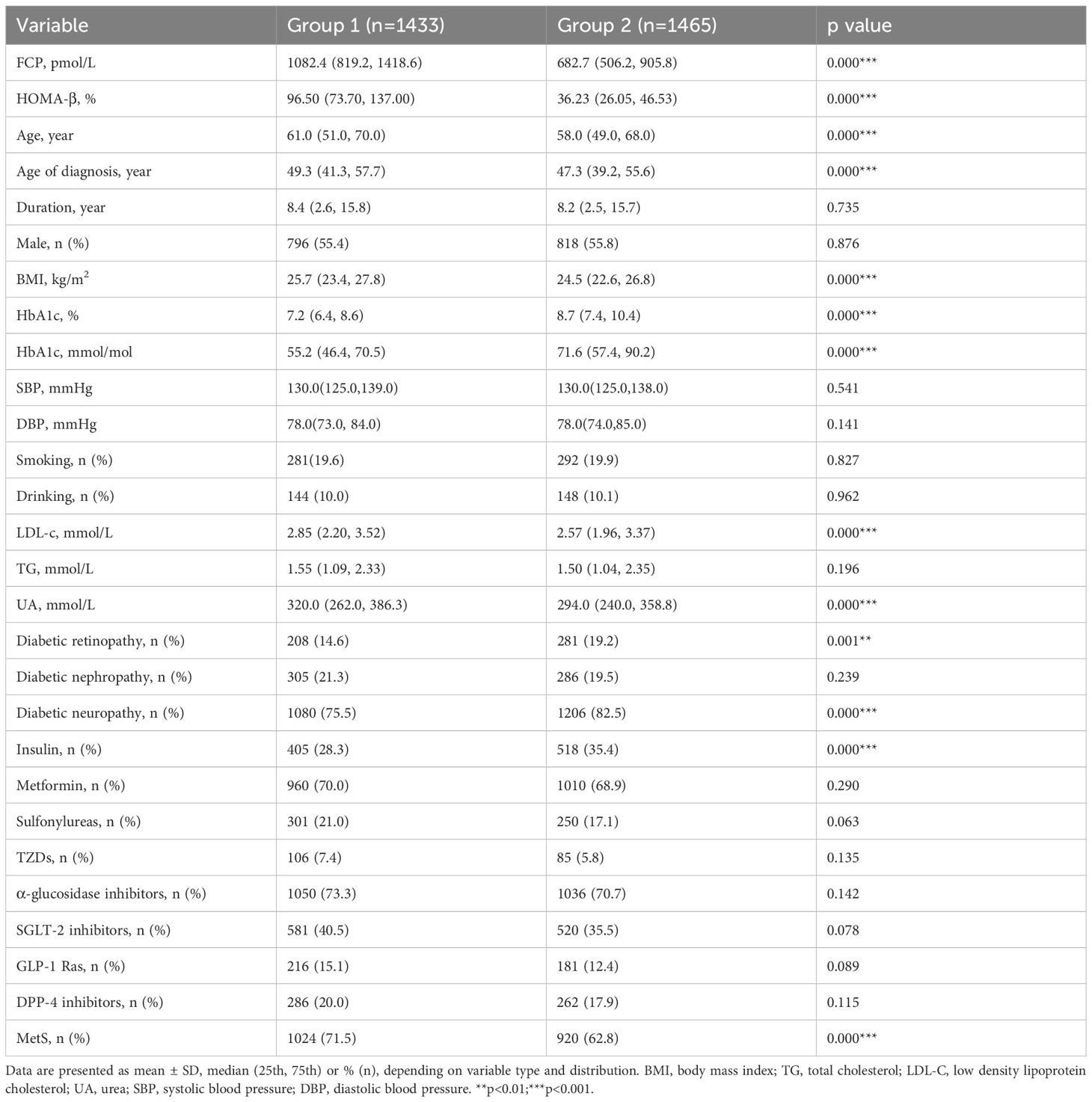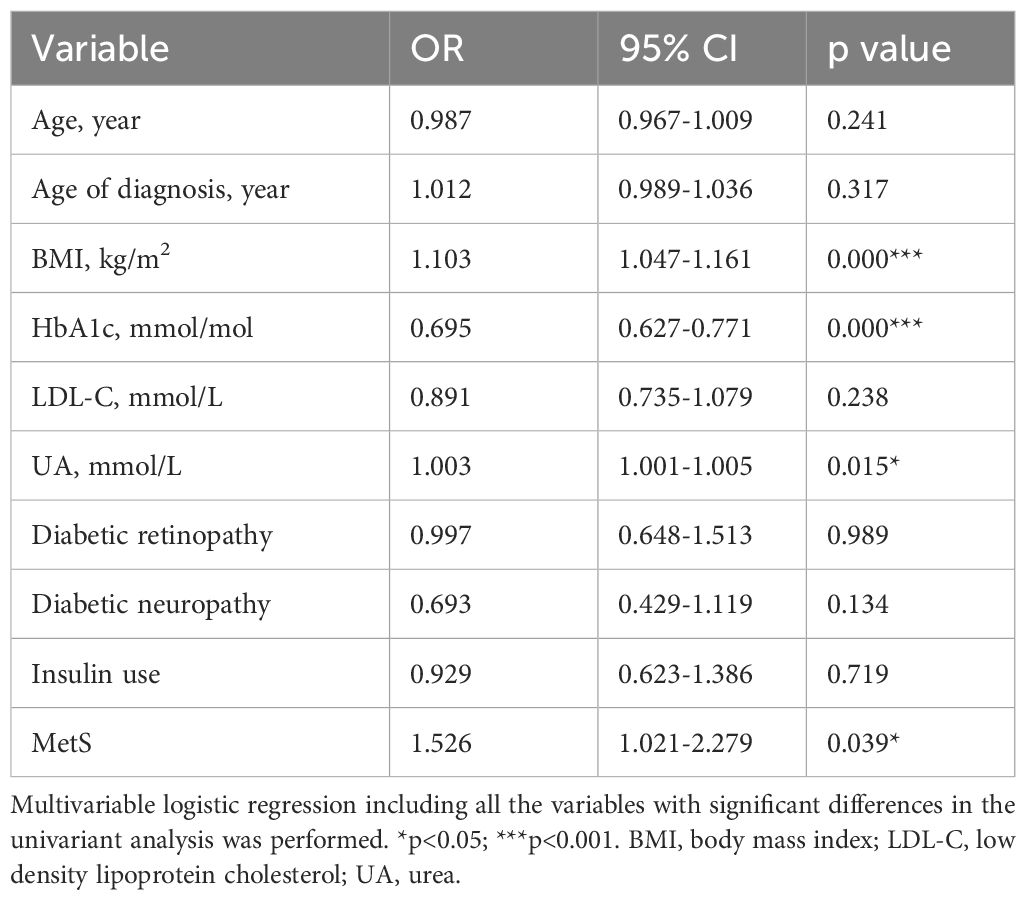- Department of Metabolism and Endocrinology, The Second Affiliated Hospital of Zhengzhou University, Zhengzhou, Henan, China
Aims: Based on cross-sectional and follow-up data, we aimed to explore the continuous long-term pattern of beta-cell function change in type 2 diabetes and to analyze the relevant influencing factors.
Materials and methods: Data from 2898 type 2 diabetic subjects were retrospectively analyzed. Islet beta-cell function was evaluated by the homeostasis model assessed index (HOMA-β). The pattern of association between HOMA-β and disease duration coverup of 50 years were explored using non-linear regression approaches. Findings were replicated in longitudinal follow-up data from multi-centers. Influencing factors of both residual HOMA-β level and HOMA-β decline rate were investigated.
Results: We identified a model including three clear phases of HOMA-β change: an initial ascending phase over 4.2 years from diagnosis (3.34% change per year [95%CI 0.04, 6.52]), followed by a phase of exponential fall up to 20.9 years from diagnosis (-3.04% change per year [95%CI -3.78, -2.29]) and thereafter a low and plateau phase (0.17% change per year [95% CI -0.72, 1.05]). Longitudinal follow-up data verified this model. Higher BMI (OR = 1.103 [95%CI 1.047, 1.161]), UA (OR = 1.003 [95%CI 1.001, 1.005]), metabolic Syndrome (OR = 1.526 [95%CI 1.021, 2.279]) and lower HbA1c (OR = 0.695 [95%CI 0.627, 0.771]) levels were independently associated with higher residual HOMA-β level. Earlier diagnosis (Coefficient=0.0009 [95%CI 0.0002, 0.0016]) was independently associated with faster HOMA-β decline.
Conclusions: Beta-cell function change in the course of type 2 diabetes was nonlinear with multi-phases. Targeting the factors that affect different phases would contribute to the protection of the disease progression.
1 Introduction
Type 2 diabetes mellitus is characterized by insulin resistance and a progressive loss of islet beta-cell function (1). Although both factors contributed to the pathogenesis, decreased beta-cell function and beta-cell mass are the predominant factors of disease progression, and are the typical hallmark of the overt-diabetes (1). In fact, studies including the United Kingdom Prospective Diabetes Study (UKPDS) (2) have revealed that despite its latent nature, beta-cell function impairment was indeed an early event in the course of the disease. As such, only 50% of beta-cell function remained at diagnosis and continued declining at a rate of 5% annually (2). Moreover, the impaired beta-cell function is closely related to oral treatment failure, blood glucose fluctuation, microvascular or macrovascular complication, and an increased mortality (3–6). Therefore, protecting beta-cell function is an essential goal in the prevention and treatment of type 2 diabetes (7).
A comprehensive understanding of the natural history of type 2 diabetes, especially the trajectory of beta-cell function change, would provide a significant theoretical basis for preventing and treating the disease. Some studies have explored this issue and reported that rates of beta-cell decline varied (2, 8–11). However, most of these studies focused on Western populations and were virtually small-sample, short follow-up observations with highly selected subjects. Furthermore, none of these studies revealed the continuous long-term pattern of beta-cell function change. Besides, the prevalence of type 2 diabetes in China has increased over 10-fold in the past 40 years, which now has the largest type 2 diabetes population in the world (12). Therefore, data from the Chinese type 2 diabetes populations would provide significant support.
To address these gaps, this study recruited 2898 Chinese type 2 diabetes patients and detected their beta-cell function change trajectory over 50 years. The relevant influencing factors were also analyzed. Thus, this study would help further clarify the model of beta-cell function change, identifying optimal intervention timing and targets.
2 Materials and methods
2.1 Subjects
2.1.1 Cross-sectional cohort
This study was conducted in accordance with the guidelines of the Declaration of Helsinki (as revised in 2008). All patients provided informed consent to participate in the study. The study protocol was approved by the Research Ethics Committee of the Second Affiliated Hospital of Zhengzhou University (No. KY2024134). We retrospectively analyzed data from 6072 subjects with diabetes who received treatment in the Department of Endocrinology, Second Affiliated Hospital of Zhengzhou University, from June 2018 to August 2024. Participants were enrolled if they fulfilled the following criteria: (a) diabetes diagnosed according to the 1999 World Health Organization (WHO) criteria (13); (b) clinically classified as type 2 diabetes; (c) testing negative for diabetes-associated autoantibodies, namely glutamic acid decarboxylase antibody (GADA), islet cell antibody (ICA), and insulin autoantibody (IAA) (for patients with a history of insulin use, IAA was not included in the analysis). Exclusion criteria included: (a) classification as type 1 diabetes mellitus [defined as an acute-onset, insulin-dependent disease at diagnosis caused by beta-cell destruction, according to guidelines from WHO (13) and the American Diabetes Association (ADA) (14)], gestational diabetes, or other special types of diabetes; (b) pregnancy or lactation; (c) receipt of hormone therapy or chemotherapy; (d) comorbidity with renal insufficiency [since blood C-peptide levels in patients with renal function impairment are artificially elevated (15)] or malignant disease. A total of 4995 patients met the above criteria. Subjects lacking measurements of fasting C-peptide (FCP), fasting plasma glucose (FPG), disease duration, or other relevant data were excluded. Finally, 2,898 subjects were included in the cross-sectional analysis (Figure 1).
2.1.2 Longitudinal cohort
We tested the findings in the cross-sectional cohort by analyzing changes over time in HOMA-β using repeat samples from individuals. The repeated samples were recruited from our own cohort and an external cohort from the same geographic region (Zhengzhou City, China). Both cohorts used the same inclusion and exclusion criteria for T2DM.
In our own cohort, repeat HOMA-β measurements were available for 1213 subjects from the 2898 individuals in the cross-sectional cohort. After excluding subjects whose HOMA-β measurement time points fell into different stage intervals (referring to the three stages described in the ‘Results’ section), a total of 3316 HOMA-β values from 1137 patients were included in the final analysis. A median (IQR) of 2 (2, 3) results were available per subject, over a median (IQR) of 3.5 (1.8, 5.9) years of follow-up.
The external data come from a prospective cohort based at the National Metabolic Management Center (MMC) (16) sub-center established by the Fifth Affiliated Hospital of Zhengzhou University. This study was approved by the Ethics Committee of the Fifth Affiliated Hospital of Zhengzhou University (No. KY20211019), and all patients signed the informed consent form for enrollment. A total of 705 HOMA-β measurements from 237 patients were included in the analysis. A median (IQR) of 2 (2, 3) results were available per patient, over a median (IQR) of 9.2 (3.3, 25.2) months of follow-up.
The following information was collected at each visit: disease duration, BMI, systolic blood pressure (SBP), and diastolic blood pressure (DBP). Moreover, serum was collected for measurements of plasma glucose, HbA1c, C-peptide, triglycerides (TG), low-density lipoprotein cholesterol (LDL-C), uric acid (UA), and diabetes-associated autoantibodies.
2.2 Laboratory analysis
Height, weight, and blood pressure were measured with a standardized procedure, and BMI was calculated. Levels of FPG, TG, LDL-C, and UA were determined using the automatic chemistry system at the core laboratory of the Second Affiliated Hospital of Zhengzhou University. HbA1c was measured using high-performance automated liquid chromatography (HLC-723G8, Tosoh, Japan). GADA and ICA were qualitatively detected using a standard immunoblot kit (BLOT, Shenzhen, China). Plasma C-peptide was tested using the electrochemical luminescence method (cobas-E411, Basel, Switzerland). Furthermore, the inter-assay and intra-assay variation coefficients were 3.7–4.1% and 1.0–3.3%, respectively. The lower detection limit of the assay was 16.7 pmol/L.
Fasting plasma glucose (FPG) and fasting C-peptide (FCP) were tested in patients fasting for at least 8 hours. HOMA-β was calculated using the following formula: HOMA-β (%) =0.27×FCP (pmol/L)/[FPG (mmol/L)-3.5] (17).
Metabolic Syndrome (MetS) was defined using the 2017 Chinese Diabetes Society’s (CDS) criteria (18) and was diagnosed when three or more of the following criteria were met: (a) abdominal obesity: waist circumference ≥90 cm in men and ≥85 cm in women; (b) hyperglycemia: FBS ≥6.1 mmol/L or 2-hour PBS ≥7.8 mmol/L or previously diagnosed diabetes with treatment; (c) hypertension: blood pressure ≥130/85 mmHg or currently under antihypertension therapy; (d) fasting TG ≥1.70 mmol/L; (e) fasting HDL-C<1.04 mmol/L.
2.3 Statistical analysis
HOMA-β results were natural log transformed for analysis as the distribution of its values was heavily skewed. Initial analysis of cross-sectional data used non-linear regression modeling to examine the association between duration and HOMA-β. Generalized additive models (GAM) were used to explore the initial shape of the associations. Notably, this revealed a pattern consistent with three phases that could be modeled with three lines of best fit. Segmented regression was then used to determine the optimal breakpoints where the lines of best fit would meet and to enable calculation of the intercept and slopes of different phases, thereby modeling the starting point and rate of HOMA-β decline. The intercepts were back-transformed (using the exponential) to estimate HOMA-β levels at diagnosis from the models. As slopes were on a log scale, they were interpreted as percentage change per year (calculated from the exponential of the β coefficient minus 1).
For the longitudinal analysis, data were split into three groups for the three phases: before and after the optimal breakpoints identified from cross-sectional analysis. The slopes of the three phases were determined using mixed effects models to model HOMA-β against duration, with random effects at the patient level to allow each patient to contribute multiple values at different time points. We used a random-intercept, random-slope model to allow for variability between individuals. Moreover, we excluded those whose first value was below the lower limit of detection of the assay to ensure the finding did not represent a floor effect (i.e., that the results were not an artifact of those below the lower limit of the assay unable to fall).
We further explored clinical indicators related to residual HOMA-β levels using cross-sectional data. Based on longitudinal data, we incorporated the duration of diabetes as a continuous time-varying covariate in the mixed effect model. We explored significant associations (statistical interactions) between determinants of interest and duration of diabetes on HOMA-β levels.
All analyses were carried out in SPSS version 24.0 or R version 3.2.2, including the mgcv package (for generalized additive models), lme4 package (for mixed effects models), and segmented package (for segmented regression). Normally distributed data were presented as mean ± SD. Variables with a skewed distribution were reported as median (quartile range: 25th, 75th). Categorical variables were expressed as percentages. Normally distributed data were compared using ANOVA, and non-normally distributed data were compared using the Wilcoxon Rank Sum and Spearman correlation test. Categorical variables were compared using a chi-squared test. Furthermore, we performed univariate analyses to compare clinical features in subjects with different levels of residual beta-cell function. Multivariate logistic regression analyses were performed to further investigate the possible determinants of beta-cell function preservation. Two-sided statistical tests were performed, and a p-value <0.05 (two-sided) was considered statistically significant.
3 Results
3.1 Baseline clinical features
Clinical and biochemical characteristics of the 2898 patients in cross-sectional analysis are presented in Table 1. At baseline, the mean age was 60.0 years old (ranging from 12.0 to 94.0), and 55.7% were male. The mean age of diagnosis was 48.4 years old (ranging from 7.1 to 86.5), and the mean disease duration was 8.4 years (ranging from 0.1 to 50.0). The average BMI (IQR) level was 25.0 (23.0, 27.4) kg/m2, meeting the diagnostic criteria for overweight in China (19). The average HbA1c (IQR) level was 61.7 (50.8, 81.4) mmol/mol. Moreover, the subjects’ blood pressure, glucose, and lipids levels did not meet the strict control targets, and almost 80% of the subjects combined at least one type of diabetic microvascular or neurological complications.
3.2 Cross-sectional analysis identified multi-phases of beta-cell function change
We used GAM to investigate the changing pattern of HOMA-β with the course of the disease. HOMA-β was found to have a nonlinear association with the disease duration, suggesting three phases. As shown in Figure 2, the first phase lay within about 4 years from diagnosis, during which the curve rose slightly. This was followed by a second phase up until around 21 years after diagnosis, during which the curve declined significantly, and the HOMA-β level experienced a substantial reduction. Then, it progressed to the third phase, where the curve flattened, indicating a continuous low level of HOMA-β.

Figure 2. Scatterplots of ln (HOMA-β) against duration of diabetes in 2898 individuals with type 2 diabetes. The blue line shows generalized additive modelling (non-linear) line of best fit.
Segmented regression was used to model the slopes of different phases. The estimated HOMA-β level at diagnosis was 63.4% (95%CI: 61.4, 65.4). The breakpoints at which the slope changed were modeled at 4.20 (95%CI: 2.31, 6.09) years and 20.90 (95%CI: 16.93, 24.84) years from diagnosis. During the first stage, the annual change of HOMA-β was 3.34% (95% CI: 0.04, 6.52), suggesting that beta-cell function would experience a brief ‘ascending phase’ after clinical diagnosis. During the second stage, the HOMA-β decayed at -3.04% (95% CI: -3.78, -2.29) per year, forming the main ‘decline phase’ of beta-cell function. Then, during the third stage, the annual change for HOMA-β descended to 0.17% (95% CI: -0.72, 1.05) per year, suggesting a ‘plateau phase’ thereafter. Figure 3 shows the fitted slopes and Table 2 shows the estimated parameters during the three phases.
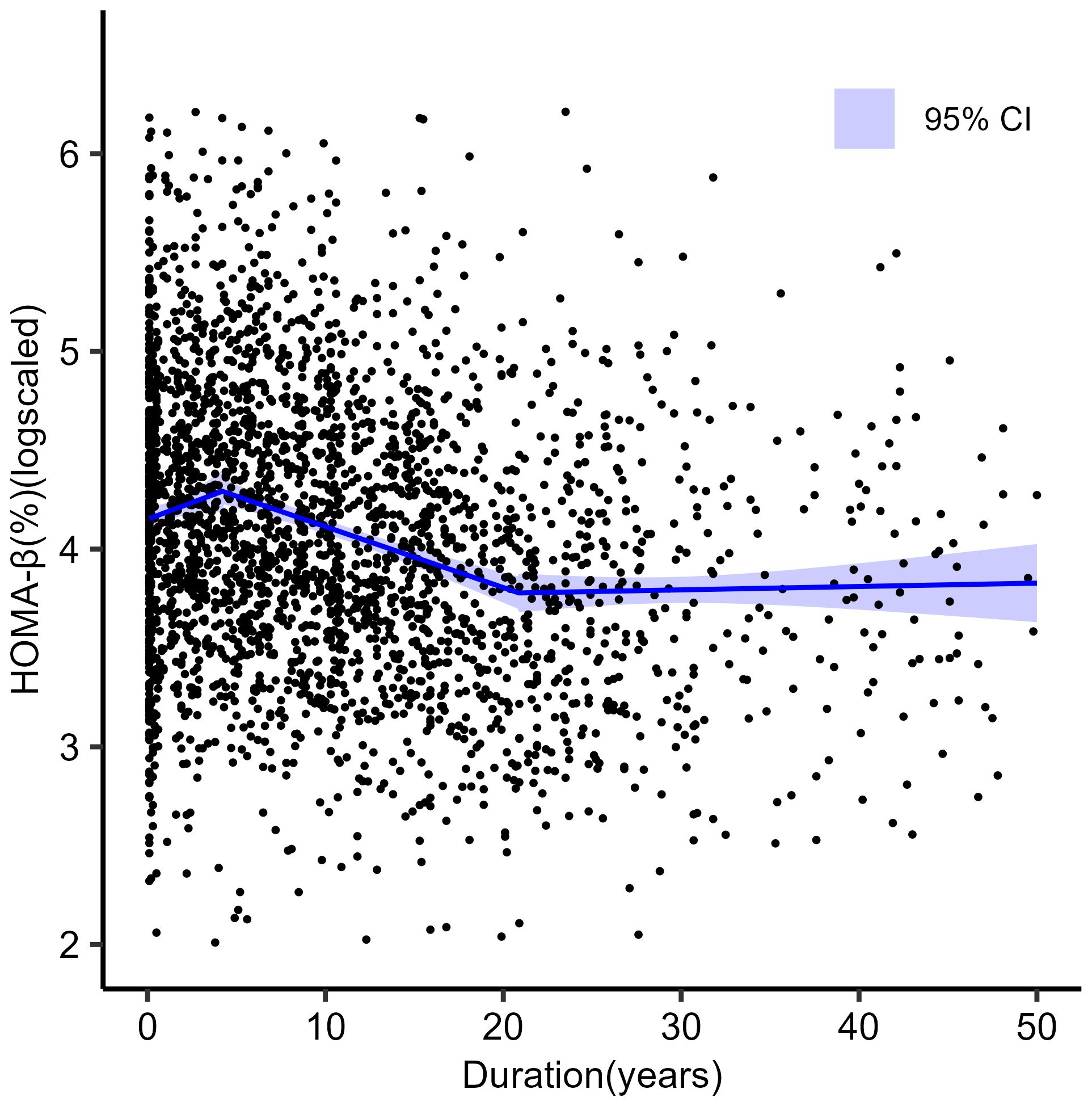
Figure 3. Scatterplots of ln (HOMA-β) against duration of diabetes in 2898 individuals with type 2 diabetes. The blue line shows three straight lines of best fit meeting at the optimal breakpoint from segmented regression analysis.
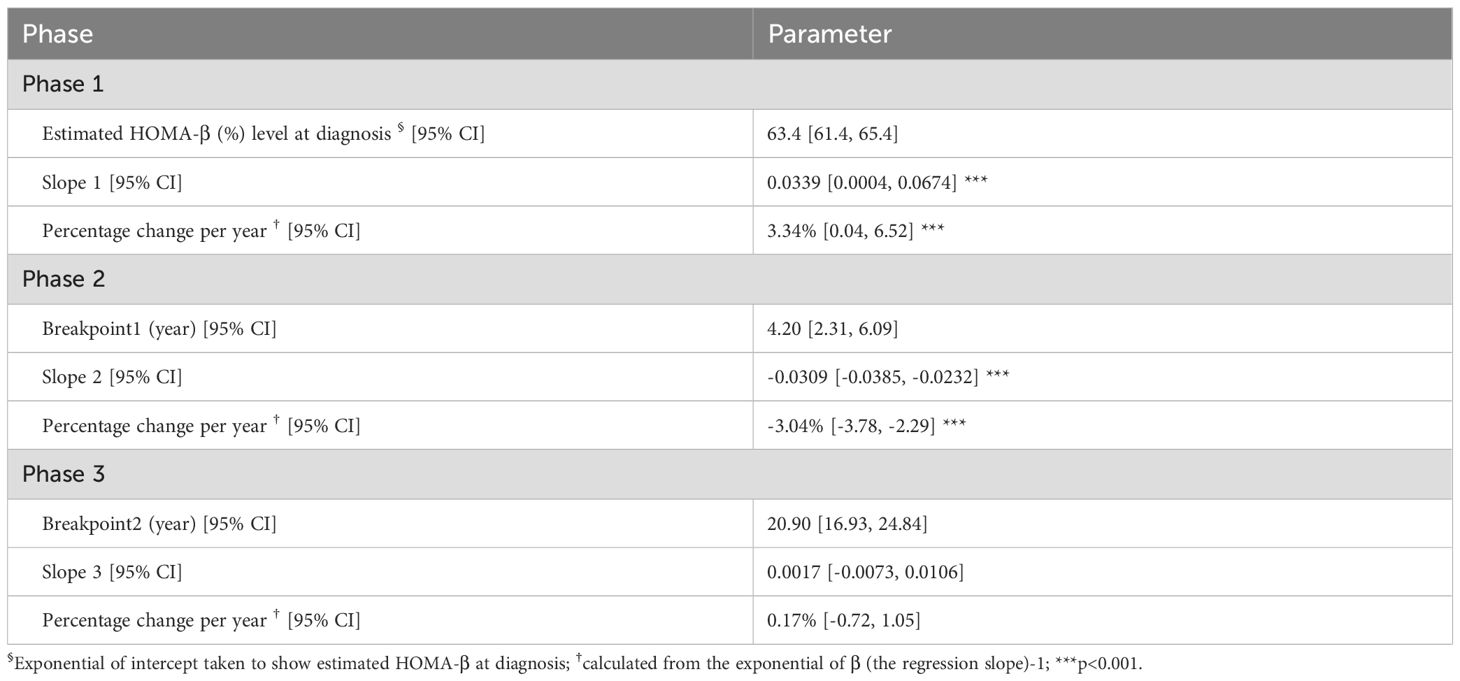
Table 2. Estimated levels and decline rates of HOMA-β from segmented regression analysis of cross-section data.
3.3 Longitudinal data validated the multi-phases in the cross-sectional model
The cross-sectional model was verified using longitudinal data from both internal and external cohorts. In line with the estimated inflection breakpoints, we calculated the slopes of each phase in the HOMA-β curve with the course of the disease using the longitudinal data. The numbers of individuals, observations, and the estimated slopes at distinct phases are presented in Table 3. The decline pattern of HOMA-β was similar to that seen in the cross-sectional model. It consisted of an initial ‘ascending stage,’ followed by a ‘decline stage’ with substantial fall, and then a continuous ‘plateau stage’.
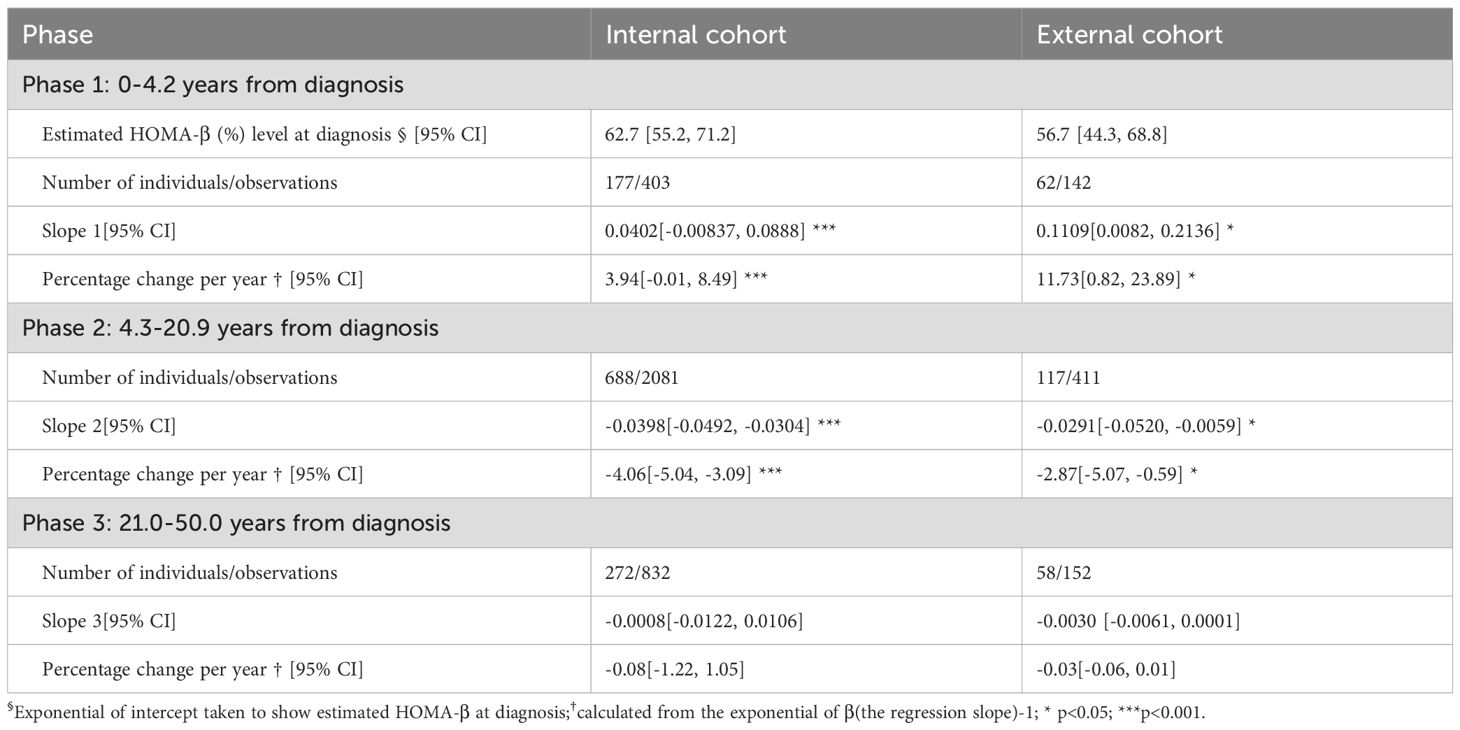
Table 3. Estimated levels and decline rates of HOMA-β from mixed effect models of longitudinal data.
3.4 Factors associated with residual beta-cell function
The 2898 subjects in the cross-sectional analysis were grouped according to their residual HOMA-β levels. Subjects with their HOMA-β points above the GAM model fitting curve (Figure 1) were considered to have ‘preferable residual beta-cell function’ and classified into ‘Group 1’. In contrast, others having ‘inferior beta-cell function’ were assigned to ‘Group 2’.
Univariate analysis showed that compared to Group 2, age (61.0 vs. 58.0 years, p<0.001), age of diagnosis (49.3 vs. 47.3 years, p<0.001), BMI (25.7 vs. 24.5 kg/m², p<0.001), levels of LDL-C (2.85 vs. 2.57 mmol/L, p<0.001), UA (320.0 vs. 294.0 mmol/L, p<0.001) and proportion of MetS (71.5% vs. 62.8%, p<0.001) were higher in Group 1. In comparison, the HbA1c level (55.2 vs.71.6 mmol/mol, p<0.001) and proportion of insulin use (28.3% vs. 35.4%) were lower in Group 1. Notably, the proportions of diabetic retinopathy (19.2% vs. 14.6%), diabetic neuropathy (82.5% vs. 75.5%) and in Group 1 were significantly higher than those in Group 2 (Table 4).
Further multivariate analyses showed that higher BMI levels (OR = 1.103, [95%CI 1.048, 1.161], p<0.001), UA levels (OR = 1.003, [95%CI 1.001, 1.005], p=0.014), MetS (OR = 1.526, [95%CI 1.021, 2.279], p=0.039) and lower HbA1c levels (OR = 0.696, [95%CI 0.628, 0.771], p<0.001) were independently associated with higher residual HOMA-β level (Table 5).
3.5 Factors associated with beta-cell function decline rate
We focused on the second stage in the above models, which was the main ‘decline phase’ of HOMA-β. Using longitudinal follow-up data, the mixed effect linear model showed that HOMA-β levels decreased with increased disease duration and HbA1c levels. Notably, the age of diagnosis was associated with HOMA-β decline rate since there was a significant interaction (Coefficient=0.0009 [95%CI: 0.0002, 0.0016]) between age of diagnosis and disease duration on HOMA-β levels over time. This suggests that the earlier the disease diagnosis, the faster the rate at which HOMA-β declines with the disease course (Table 6).
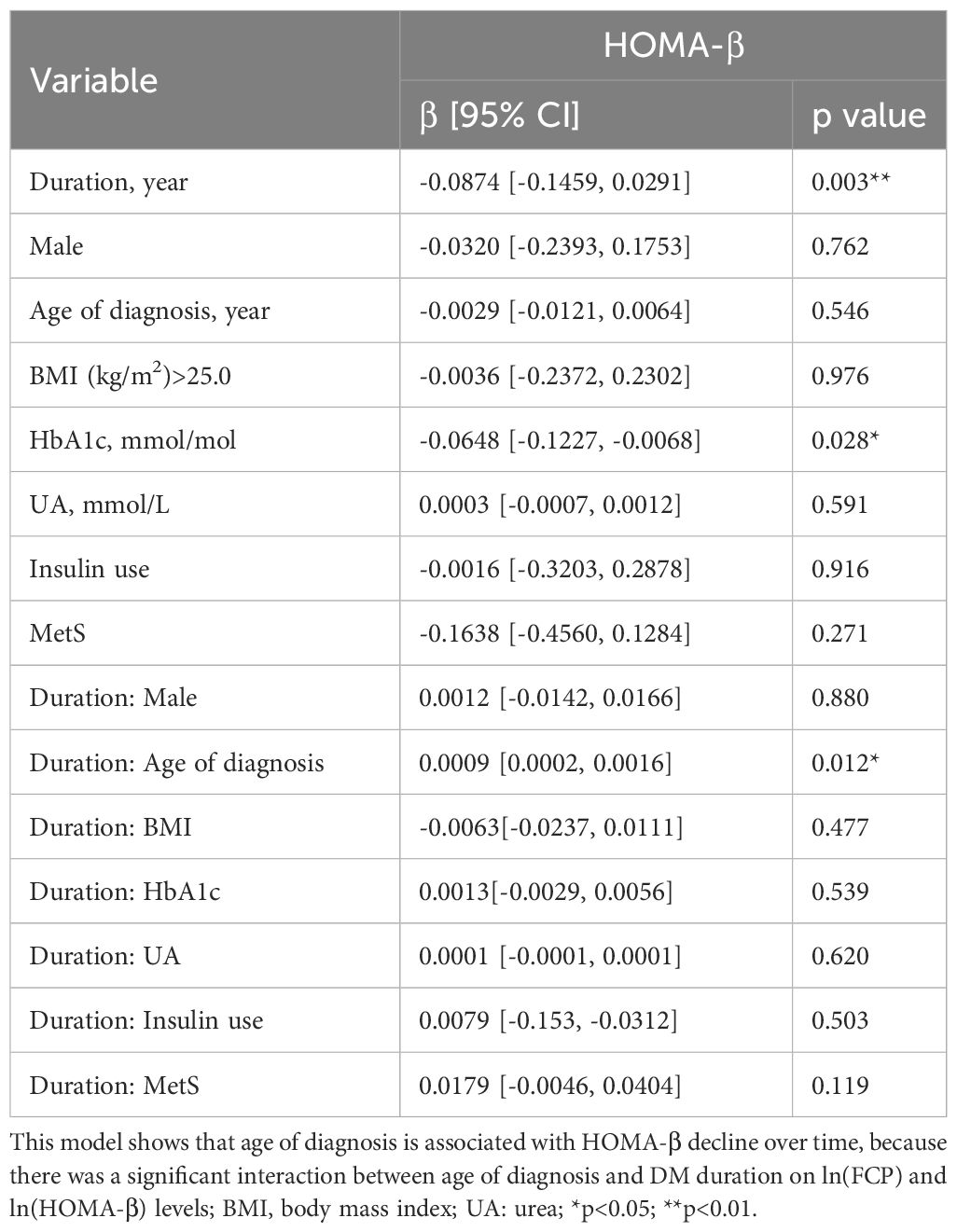
Table 6. Longitudinal mixed model exploring the effect of clinical characteristics on FCP and HOMA-β levels over time.
4 Discussion
The “three-phase HOMA-β model” is clinically relevant and highly consistent with previous literature. Firstly, the “ascending phase” usually emerges after short-term interventions (such as intensive insulin therapy, oral medications, or lifestyle interventions), accompanied by increased insulin secretion and improved glycemic control. This so-called “clinical remission period” (9, 20–22) is equivalent to the first stage in this study. Secondly, the following ‘decline phase’ was also witnessed. The well-known UKPDS reported a decline rate of 5% per year in British type 2 diabetic patients (2), while in Chinese populations, this figure was 2% (11). Different genetic backgrounds, intervention programs may contribute to the varied decline rates. Thirdly, as for the ‘plateau phase,’ the Veterans Affairs Diabetes Trial (VADT) showed that the C-peptide levels decreased progressively from 0–3 years after diagnosis until 15 years’ duration and then remained stable after 16–18 years, suggesting that beta-cell function loss would tend to stabilize at a certain point (10).
Moreover, the continues change pattern was also observed. The Belfast Diet Study (8) used HOMA-β to explore changes in beta-cell function in type 2 diabetic patients and found an initial slow decline (1.7% decline per year) period followed by a rapid decline (18.2% decline per year). Unfortunately, the follow-up was terminated before the 10th year post-diagnosis, so no further changes thereafter were observed. More consistent results came from another Chinese study (23). Ding et al. followed 1570 type 2 diabetic subjects for up to 35 years. They found that beta-cell function remained unchanged within 5 years after diagnosis, declined by 2% annually between 5 and 22 years, and remained at a low level thereafter (23). Despite the detailed differences, the above results are consistent with this study.
As for the potential underlying pathophysiological mechanisms, each phase needs to be discussed separately. The beta-cell function decline in type 2 diabetes broadly resulted from beta-cell number reduction, beta-cell exhaustion, and beta-cell de-differentiation or trans-differentiation into other cell types (24), all closely related to glucotoxicity/lip-toxicity (25). Apart from beta-cell number reductions, which are difficult to reverse, the other two processes can be reversed after removing glucotoxicity/lip-toxicity (24).
In this model, the first ‘ascending phase’ may result from the glucose and lipid-lowering therapy initiated after diagnosis which improved the underlying pathophysiological conditions and restored beta-cell function. Therefore, early screening and treatment should be conducted to seize the time window for beta-cell protection (26) (Figure 4). The following ‘decline phase’ was described by A. Bagust as the ‘fully developed stage of type 2 diabetes’, which was characterized by a significant irreversible decline of beta-cell function (8). Its relevant pathophysiological processes may include accelerated beta-cell apoptosis, rapid beta-cell exhaustion, and irreversible beta-cell dedifferentiation (8) (Figure 4). Moreover, the Counterpoint Study (27) and The Scandinavian Obesity Study (28) confirmed that as the duration of diabetes increases, an irreversible ‘turning point’ would be passed with beta-cells underwent irreversible damage. Regarding this ‘turning point’, B. TOPP et al. put forward a hypothesis (29):a regulation system would attempt to maintain the insulin secretion level by reducing beta-cell loss and/or increasing beta-cell replication at the early stage of the disease. However, the regulatory ability gradually weakens and eventually reaches an unstable saddle point at which even a modest event (such as an infection or an over-indulgence) would propel the subject into the subsequent phase of sudden accelerated disease progression. During the last ‘plateau phase’, patients tend to have persistently low levels of beta-cell function, resulting in failed oral drug treatment, drastic blood sugar fluctuation, and multiple complications (3–6). Insulin therapy often needs to be initiated at this stage (Figure 4).
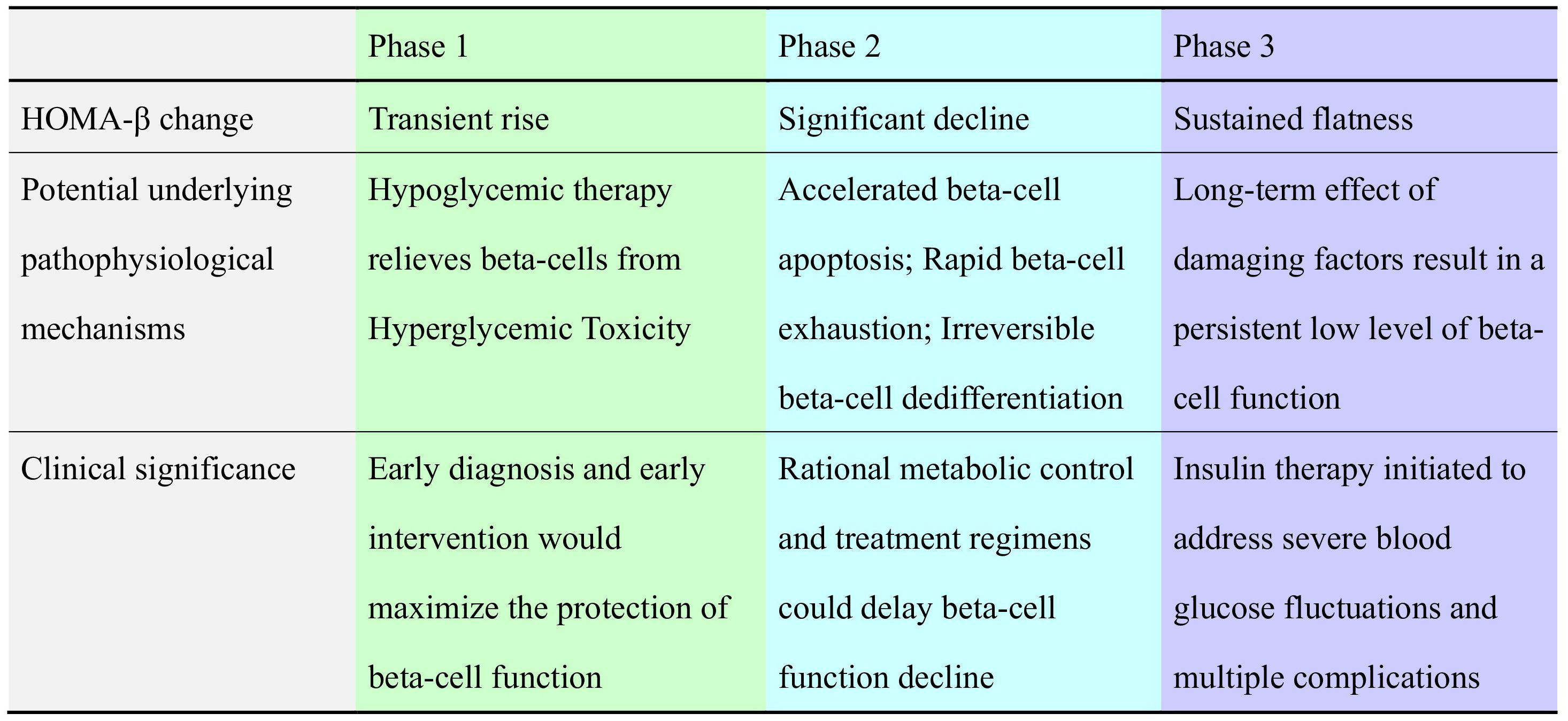
Figure 4. Potential underlying pathophysiological mechanisms and clinical features of the ‘three-phase model’.
We further analyzed clinical factors associated with residual beta-cell function. Univariate analysis showed inverse correlations of diabetic retinopathy and diabetic neuropathy, which was consistent with previous reports (6). After adjusting for multiple variables, higher BMI, UA and MetS proportion levels were still correlated with higher residual HOMA-β level. The positive correlations were particularly significant among overweight or obese subjects (30, 31). Notably, this did not mean MetS is beneficial to beta-cell preservation, since free fatty acids, UA, and related inflammation could cause insulin resistance and a compensatory increase in insulin secretion, which would ultimately damage beta-cell function (32, 33). In this study, the average BMI level was 25.0 kg/m², reaching the criteria of overweight for Chinese (16). Therefore, fat loss and muscle building should be conducted in this group of people (34). The elevated HbA1c and reduced beta-cell function were thought to be causally related: the glucotoxicity may damage beta-cell function (24) while correspondingly, the decreased insulin level would cause an increased blood glucose level (5). Therefore, active blood glucose control can break this vicious cycle and prevent disease progression.
We also observed that insulin use was related to lower residual HOMA-β levels. However, prior studies demonstrated that early insulin intervention preserves beta-cell function (35). This suggests that insulin treatment would be initiated belatedly in our patients, potentially missing the optimal window for beta-cell protection. Thus, in clinical practice, adequate attention should be paid to beta-cell function protection. Timely use of agents with potential β-cell-protective effects [e.g., GLP-1Ras (36), SGLT-2 inhibitors (37), DPP-4 inhibitors (38)] is advisable.
Moreover, we found that early disease onset was associated with faster beta-cell function decline. Similar results have been reported in the ‘Restoring Insulin Secretion (RISE) Study’ and ‘Treatment Options for Type 2 Diabetes in Adolescents and Youth (TODAY) Study’ (39, 40). This arises from both genetic and environmental factors. A genome-wide association study (GWAS) by the Progress in Diabetes Genetics in Youth Consortium (ProDiGY) (41) highlighted the key role of genetic background. In contrast, socio-environmental factors—such as later bedtimes (42) and fewer medical visits (43)—may reduce residual beta-cell function. Unfortunately, the incidence and prevalence of early-onset type 2 diabetes (in those aged ≤40 years) are rising globally (1). Thus, early combination therapy is recommended for young adults (<40 years) with type 2 diabetes (44).
The strengths of our study are as follows. First, we had a large sample size of 2892 subjects and a prolonged disease course coverage of 50 years. This ensured the statistical power and enabled long-term continuous observation. Second, the diabetic-associated antibodies including IAA, GADA and ICA, were detected to exclude autoimmune diabetes such as LADA (45). This largely reduces the heterogeneity of the cohort. Third, this study combined cross-sectional and longitudinal data from multi-centers, which enhanced the reliability of the conclusions.
The limitations of our study are as follows. First, although the results are consistent with previous studies, it must be noted that the ‘three-phase HOMA-β model’ is still largely based on statistical analysis of a single Chinese Han population. The turning points and change rates within each phase may vary among different populations. Also, variability in treatment regimens, survivor bias, or misclassification of disease onset might affect the existence of multi-phases. Therefore, multi-center, large-sample prospective studies across diverse ethnic groups should be conducted in the future, and the underlying pathophysiological mechanisms also require further investigations. Second, despite the strict control over the inclusion and exclusion criteria, it is still possible that some LADA and classic T1DM patients were included, which increases the heterogeneity of the cohort. Third, this study used HOMA-β to evaluate beta-cell function, which reflected basal insulin secretion (46) but failed to capture the dynamic changes in insulin response. We will strive to adopt OGTT-derived indices in future studies to more comprehensively reflect beta-cell function.
In conclusion, this study revealed the complex model of beta-cell function change in type 2 diabetes. Based on this model, the pathophysiological mechanisms underlying different phases would be investigated and targeted clinical interventions could be implemented in the specific population.
Data availability statement
The original contributions presented in the study are included in the article/Supplementary Material. Further inquiries can be directed to the corresponding authors.
Ethics statement
The studies involving humans were approved by the Research Ethics Committee of the Second Affiliated Hospital of Zhengzhou University (approval No. KY2024134). The studies were conducted in accordance with the local legislation and institutional requirements. Written informed consent for participation in this study was provided by the participants' legal guardians/next of kin.
Author contributions
JC: Data curation, Formal Analysis, Methodology, Resources, Writing – original draft, Writing – review & editing. JL: Data curation, Funding acquisition, Writing – review & editing. YX: Data curation, Formal Analysis, Investigation, Resources, Writing – review & editing. DZ: Data curation, Funding acquisition, Project administration, Writing – review & editing.
Funding
The author(s) declare financial support was received for the research and/or publication of this article. Dongming Zhang and Jun Li received funding from Health Commission of Henan Province (Grant No. LHGJ20240329 and LHGJ20220453) for the article processing charges. The funder was not involved in the design of the study; the collection, analysis and interpretation of data; writing the report; and did not impose any restrictions regarding the publication of the report.
Acknowledgments
We thank all participants of the study. The authors thank AiMi Academic Services (www.aimieditor.com) for English language editing and review services.
Conflict of interest
The authors declare that the research was conducted in the absence of any commercial or financial relationships that could be construed as a potential conflict of interest.
Generative AI statement
The author(s) declare that no Generative AI was used in the creation of this manuscript.
Any alternative text (alt text) provided alongside figures in this article has been generated by Frontiers with the support of artificial intelligence and reasonable efforts have been made to ensure accuracy, including review by the authors wherever possible. If you identify any issues, please contact us.
Publisher’s note
All claims expressed in this article are solely those of the authors and do not necessarily represent those of their affiliated organizations, or those of the publisher, the editors and the reviewers. Any product that may be evaluated in this article, or claim that may be made by its manufacturer, is not guaranteed or endorsed by the publisher.
Supplementary material
The Supplementary Material for this article can be found online at: https://www.frontiersin.org/articles/10.3389/fendo.2025.1602796/full#supplementary-material
References
1. Ahmad E, Lim S, Lamptey R, Webb DR, and Davies MJ. Type 2 diabetes. Lancet. (2022) 400:1803–20. doi: 10.1016/S0140-6736(22)01655-5
2. Wright A, Burden AC, Paisey RB, Cull CA, and Holman RR. Sulfonylurea inadequacy: efficacy of addition of insulin over 6 years in patients with type 2 diabetes in the U.K. Prospective Diabetes Study (UKPDS 57). Diabetes Care. (2002) 25:330–6. doi: 10.2337/diacare.25.2.330
3. Gedebjerg A, Bjerre M, Kjaergaard AD, Nielsen JS, Rungby J, Brandslund I, et al. CRP, C-peptide, and risk of first-time cardiovascular events and mortality in early type 2 diabetes: A Danish cohort study. Diabetes Care. (2023) 46:1037–45. doi: 10.2337/dc22-1353
4. Aziz F, Sternad C, Sourij C, Knoll L, Kojzar H, Schranz A, et al. Glycated hemoglobin, HOMA2-B, C-peptide to glucose ratio and type 2 diabetes clusters as predictors for therapy failure in individuals with type 2 diabetes without insulin therapy: A registry analysis. Diabetes Obes Metab. (2024) 26:1082–9. doi: 10.1111/dom.15409
5. Unger RH and Grundy S. Hyperglycemia as an inducer as well as a consequence of impaired islet cell function and insulin resistance: implications for the management of diabetes. Diabetologia. (1985) 28:119–21. doi: 10.1007/bf00273856
6. Bo S, Cavallo-Perin P, Gentile L, Repetti E, and Pagano G. Relationship of residual beta-cell function, metabolic control and chronic complications in type 2 diabetes mellitus. Acta Diabetol. (2000) 37:125–9. doi: 10.1007/s005920070014
7. Zhu J, Han J, Liu L, Liu L, Liu Y, Xu W, et al. Clinical expert consensus on the assessment and protection of pancreatic islet β-cell function in type 2 diabetes mellitus. Diabetes Res Clin Pract. (2023) 197:110568. doi: 10.1016/j.diabres.2023.110568
8. Bagust A and Beale S. Deteriorating beta-cell function in type 2 diabetes: a long-term model. QJM. (2003) 96:281–8. doi: 10.1093/qjmed/hcg040
9. Kahn SE, Lachin JM, Zinman B, Haffner SM, Aftring RP, Paulet G, et al. Effects of rosiglitazone, glyburide, and metformin on β-cell function and insulin sensitivity in ADOPT. Diabetes. (2011) 60:1552–60. doi: 10.2337/db10-1392
10. Duckworth WC, Abraira C, Moritz TE, Davis SN, Emanuele N, Goldman S, et al. The duration of diabetes affects the response to intensive glucose control in type 2 subjects: the VA Diabetes Trial. J Diabetes Complications. (2011) 25:355–61. doi: 10.1016/j.jdiacomp.2011.10.003
11. Chen Y, Jiang Q, Xing X, Yuan T, and Li P. Clinical research progress on β-cell dysfunction in T2DM development in the Chinese population. Rev Endocr Metab Disord. (2024) 26(1):31–53. doi: 10.1007/s11154-024-09914-9
12. Li Y, Teng D, Shi X, Qin G, Qin Y, Quanet H, et al. Prevalence of diabetes recorded in mainland China using 2018 diagnostic criteria from the American Diabetes Association: national cross sectional study. BMJ. (2020) 369:m997. doi: 10.1136/bmj.m997
13. Alberti KG and Zimmet PZ. Definition, diagnosis and classification of diabetes mellitus and its complications. Part 1: diagnosis and classification of diabetes mellitus provisional report of a WHO consultation. Diabetes Med. (1998) 15:539–53. doi: 10.1002/(sici)1096-9136(199807)15:7%3C539::aid-dia668%3E3.0.co;2-s
14. Committee ADAPP. Diagnosis and classification of diabetes: standards of care in diabetes-2025. Diabetes Care. (2025) 48:S27–49. doi: 10.2337/dc25-S002
15. Covic AM, Schelling JR, Constantiner M, Iyengar SK, and Sedor JR. Serum C-peptide concentrations poorly phenotype type 2 diabetic end-stage renal disease patients. Kidney Int. (2000) 58:1742–50. doi: 10.1046/j.1523-1755.2000.00335.x
16. Zhang Y, Wang W, and Ning G. Metabolic Management Center: An innovation project for the management of metabolic diseases and complications in China. J Diabetes. (2019) 11:11–3. doi: 10.1111/1753-0407.12847
17. Pancreatic Islet β−cell Expert Panel of Chinese Diabetes Society, Endocrinology Society of Jiangsu Medical Association. Expert consensus on the assessment and protection of pancreatic islet β−cell function in patients with type 2 diabetes mellitus. Chin J Diabetes Mellitus. (2022) 14:533–43. doi: 10.3760/cma.j.cn115791-20220104-00005
18. Chinese Diabetes Society. Guidelines for prevention and treatment of type 2 diabetes in Chinese (2017 edition). Chin J Diabetes Mellitus. (2018) 10:4–67. doi: 10.3760/cma.j.issn.1674-5809.2018.01.003
19. Zeng Q, Li N, Pan XF, Chen L, and Pan A. Clinical management and treatment of obesity in China. Lancet Diabetes Endocrinol. (2021) 9:393–405. doi: 10.1016/s2213-8587(21)00047-4
20. Li Y, Xu W, Liao Z, Yao B, Chen X, Huang Z, et al. Induction of long-term glycemic control in newly diagnosed type 2 diabetic patients is associated with improvement of beta-cell function. Diabetes Care. (2004) 27:2597–602. doi: 10.2337/diacare.27.11.2597
21. RISE Consortium and RISE Consortium Investigators. Effects of treatment of impaired glucose tolerance or recently diagnosed type 2 diabetes with metformin alone or in combination with insulin glargine on β-cell function: comparison of responses in youth and adults. Diabetes. (2019) 68:1670–80. doi: 10.2337/db19-0299
22. Churuangsuk C, Hall J, Reynolds A, Griffin SJ, Combet E, and Lean M. Diets for weight management in adults with type 2 diabetes: an umbrella review of published meta-analyses and systematic review of trials of diets for diabetes remission. Diabetologia. (2022) 65:14–36. doi: 10.1007/s00125-021-05577-2
23. Yu D, Qi F, Yao Q, Min S, and Tao Y. Analysis of islet beta cell function assessed by C-peptide changing with the disease duration in patients with type 2 diabetes mellitus. Chin J Diabetes Mellitus. (2020) 12:491–5. doi: 10.3760/cma.j.cn115791-20200403-00185
24. Wysham C and Shubrook J. Beta-cell failure in type 2 diabetes: mechanisms, markers, and clinical implications. Postgrad Med. (2020) 132:676–86. doi: 10.1080/00325481.2020.1771047
25. Lu X, Xie Q, Pan X, Zhang R, Zhang X, Peng G, et al. Type 2 diabetes mellitus in adults: pathogenesis, prevention and therapy. Signal Transduct Target Ther. (2024) 9:262. doi: 10.1038/s41392-024-01951-9
26. American Diabetes Association Professional Practice Committee. Pharmacologic approaches to glycemic treatment: standards of care in diabetes-2024. Diabetes Care. (2024) 47:S158–78. doi: 10.2337/dc24-er07a
27. Lim EL, Hollingsworth KG, Aribisala BS, Chen MJ, Mathers JC, and Taylor R. Reversal of type 2 diabetes: normalization of beta cell function in association with decreased pancreas and liver triacylglycerol. Diabetologia. (2011) 54:2506–14. doi: 10.1007/s00125-011-2204-7
28. Panunzi S, Carlsson L, De Gaetano A, Peltonen M, Rice T, Sjöström L, et al. Determinants of diabetes remission and glycemic control after bariatric surgery. Diabetes Care. (2016) 39:166–74. doi: 10.2337/dc15-0575
29. Topp B, Promislow K, deVries G, Miura RM, and Finegood DT. A model of beta-cell mass, insulin, and glucose kinetics: pathways to diabetes. J Theor Biol. (2000) 206:605–19. doi: 10.1006/jtbi.2000.2150
30. Fan Y, Chow E, Lim C, Hou Y, Tsoi S, Fan B, et al. Comparison of β-cell function and insulin sensitivity between normal-weight and obese Chinese with young-onset type 2 diabetes. Diabetes. (2024) 73:953–63. doi: 10.2337/db23-0966
31. Li M, Gu L, Yang J, and Lou Q. Serum uric acid to creatinine ratio correlates with β-cell function in type 2 diabetes. Diabetes Metab Res Rev. (2018) 34:e3001. doi: 10.1002/dmrr.3001
32. Ghasemi A. Uric acid-induced pancreatic β-cell dysfunction. BMC Endocr Disord. (2021) 21:24. doi: 10.1186/s12902-021-00698-6
33. McArdle MA, Finucane OM, Connaughton RM, McMorrow AM, and Roche HM. Mechanisms of obesity-induced inflammation and insulin resistance: insights into the emerging role of nutritional strategies. Front Endocrinol (Lausanne). (2013) 4:52. doi: 10.3389/fendo.2013.00052
34. American Diabetes Association Professional Practice Committee. Obesity and weight management for the prevention and treatment of type 2 diabetes: standards of care in diabetes-2024. Diabetes Care. (2024) 47:S145–57. doi: 10.2337/dc24-s008
35. Owens DR. Clinical evidence for the earlier initiation of insulin therapy in type 2 diabetes. Diabetes Technol Ther. (2013) 15:776–85. doi: 10.1089/dia.2013.0081
36. Kaneto H, Kimura T, Shimoda M, Obata A, Sanada J, Fushimi Y, et al. Favorable effects of GLP-1 receptor agonist against pancreatic β-cell glucose toxicity and the development of arteriosclerosis: “The earlier, the better” in therapy with incretin-based medicine. Int J Mol Sci. (2021) 22(15):1–11. doi: 10.3390/ijms22157917
37. Nakamura A. Effects of sodium-glucose co-transporter-2 inhibitors on pancreatic β-cell mass and function. Int J Mol Sci. (2022) 23(9):5104. doi: 10.3390/ijms23095104
38. Bugliani M, Syed F, Paula F, Omar BA, Suleiman M, Mossuto S, et al. DPP-4 is expressed in human pancreatic beta cells and its direct inhibition improves beta cell function and survival in type 2 diabetes. Mol Cell Endocrinol. (2018) 473:186–93. doi: 10.1016/j.mce.2018.01.019
39. Al-Saeed AH, Constantino MI, Molyneaux L, D'Souza M, Limacher-Gisler F, Luo C, et al. An inverse relationship between age of type 2 diabetes onset and complication risk and mortality: the impact of youth-onset type 2 diabetes. Diabetes Care. (2016) 39:823–9. doi: 10.2337/dc15-0991
40. Fan Y, Fan B, Lau E, Lim C, Wu H, Ma R, et al. Comparison of beta-cell function between Hong Kong Chinese with young-onset type 2 diabetes and late-onset type 2 diabetes. Diabetes Res Clin Pract. (2023) 205:110954. doi: 10.1016/j.diabres.2023.110954
41. Srinivasan S, Chen L, Todd J, Divers J, Gidding S, Chernausek S, et al. Erratum. The first genome-wide association study for type 2 diabetes in youth: the progress in diabetes genetics in youth (ProDiGY) consortium. Diabetes 2021;70:996-1005. Diabetes. (2022) 70(4):996–1005. doi: 10.2337/db20-0443
42. Ma M, Jiang T, Zhang D, Yao X, Wen Z, and Xiu L. Association of bedtime with early-onset diabetes and islet beta cell function in patients with newly diagnosed type 2 diabetes mellitus. Nat Sci Sleep. (2023) 15:653–62. doi: 10.2147/nss.s413992
43. Valaiyapathi B, Gower B, and Ashraf AP. Pathophysiology of type 2 diabetes in children and adolescents. Curr Diabetes Rev. (2020) 16:220–9. doi: 10.2174/1573399814666180608074510
44. Davies MJ, Aroda VR, Collins BS, Gabbay RA, Green J, Maruthur NM, et al. Management of hyperglycemia in type 2 diabetes, 2022. A consensus report by the American diabetes association (ADA) and the European association for the study of diabetes (EASD). Diabetes Care. (2022) 45:2753–86. doi: 10.2337/dci22-0034
45. Jones AG, McDonald TJ, Shields BM, Hagopian W, and Hattersley AT. Latent autoimmune diabetes of adults (LADA) is likely to represent a mixed population of autoimmune (Type 1) and nonautoimmune (Type 2) diabetes. Diabetes Care. (2021) 44:1243–51. doi: 10.2337/dc20-2834
Keywords: beta-cell, C-peptide, HOMA-β, insulin, type 2 diabetes
Citation: Cheng J, Li J, Xin Y and Zhang D (2025) Multi-phases of islet beta-cell function change in type 2 diabetes mellitus and its influencing factors. Front. Endocrinol. 16:1602796. doi: 10.3389/fendo.2025.1602796
Received: 30 March 2025; Accepted: 23 September 2025;
Published: 10 October 2025.
Edited by:
George K. Gittes, University of Pittsburgh, United StatesReviewed by:
Slavica Tudzarova, UCLA Health System, United StatesRoma Patel, Albert Einstein College of Medicine, United States
Copyright © 2025 Cheng, Li, Xin and Zhang. This is an open-access article distributed under the terms of the Creative Commons Attribution License (CC BY). The use, distribution or reproduction in other forums is permitted, provided the original author(s) and the copyright owner(s) are credited and that the original publication in this journal is cited, in accordance with accepted academic practice. No use, distribution or reproduction is permitted which does not comply with these terms.
*Correspondence: Yaping Xin, eGlueWFwaW5nMDIxM0AxNjMuY29t; Dongming Zhang, emhhbmdkbTIwMjVAMTI2LmNvbQ==
 Jin Cheng
Jin Cheng Jun Li
Jun Li